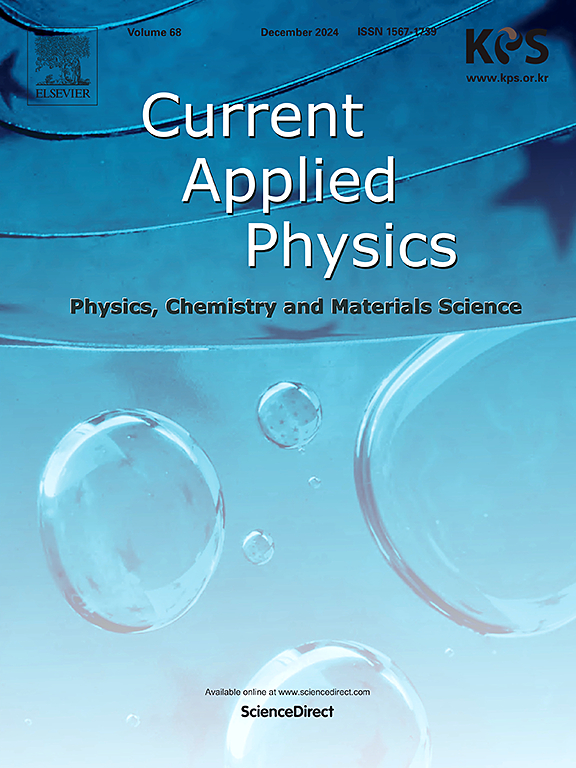Structural, electrical and optical properties of pure KNN and bismuth, antimony co-doped KNN ceramics (KNN – Bi, Sb)
IF 3.1
4区 物理与天体物理
Q3 MATERIALS SCIENCE, MULTIDISCIPLINARY
引用次数: 0
Abstract
The structural, electrical, and optical properties of bismuth (Bi) and antimony (Sb) co-doped potassium sodium niobate (KNN) ceramics were systematically investigated with a focus on their potential for energy harvesting and optoelectronic applications. X-ray diffraction (XRD) analysis revealed notable structural modifications, including the presence of a secondary phase, indicating successful incorporation of dopants and associated lattice distortions. Scanning electron microscopy (SEM) demonstrated a reduction in grain size and the formation of dense microstructures, while energy-dispersive X-ray spectroscopy (EDS) confirmed the chemical homogeneity and purity of the synthesized ceramics.
Optical characterization using UV–Vis spectroscopy showed a narrowing of the band gap and enhanced transparency in the near-infrared region. Notably, the wavelength of maximum transmittance exhibited a red shift from approximately 400 nm–650 nm. Photoluminescence (PL) measurements revealed prominent blue-green emissions, which were attributed to defect-related electronic transitions, underscoring the influence of structural and electronic defects introduced by co-doping.
Dielectric properties were assessed using impedance spectroscopy, revealing an enhancement in the dielectric constant and overall energy conversion efficiency. The findings suggest that Bi and Sb co-doping effectively tailors the multifunctional properties of KNN ceramics, thereby enhancing their suitability for next-generation energy harvesting and optoelectronic devices.

纯KNN与铋、锑共掺KNN陶瓷(KNN - Bi, Sb)的结构、电学和光学性能
系统研究了铋(Bi)和锑(Sb)共掺铌酸钾钠(KNN)陶瓷的结构、电学和光学性质,重点研究了它们在能量收集和光电子应用方面的潜力。x射线衍射(XRD)分析显示了明显的结构变化,包括二次相的存在,表明掺杂剂的成功掺入和相关的晶格畸变。扫描电子显微镜(SEM)显示了晶粒尺寸的减小和致密微观结构的形成,而能量色散x射线光谱(EDS)证实了合成陶瓷的化学均匀性和纯度。紫外可见光谱的光学表征表明,带隙缩小,近红外区域的透明度增强。值得注意的是,最大透过率波长在400 nm - 650 nm之间发生了红移。光致发光(PL)测量显示突出的蓝绿色发射,这归因于缺陷相关的电子跃迁,强调了共掺杂引入的结构和电子缺陷的影响。使用阻抗谱评估介电性能,揭示了介电常数和整体能量转换效率的增强。研究结果表明,铋和Sb共掺杂有效地调整了KNN陶瓷的多功能特性,从而增强了其在下一代能量收集和光电子器件中的适用性。
本文章由计算机程序翻译,如有差异,请以英文原文为准。
求助全文
约1分钟内获得全文
求助全文
来源期刊

Current Applied Physics
物理-材料科学:综合
CiteScore
4.80
自引率
0.00%
发文量
213
审稿时长
33 days
期刊介绍:
Current Applied Physics (Curr. Appl. Phys.) is a monthly published international journal covering all the fields of applied science investigating the physics of the advanced materials for future applications.
Other areas covered: Experimental and theoretical aspects of advanced materials and devices dealing with synthesis or structural chemistry, physical and electronic properties, photonics, engineering applications, and uniquely pertinent measurement or analytical techniques.
Current Applied Physics, published since 2001, covers physics, chemistry and materials science, including bio-materials, with their engineering aspects. It is a truly interdisciplinary journal opening a forum for scientists of all related fields, a unique point of the journal discriminating it from other worldwide and/or Pacific Rim applied physics journals.
Regular research papers, letters and review articles with contents meeting the scope of the journal will be considered for publication after peer review.
The Journal is owned by the Korean Physical Society.
 求助内容:
求助内容: 应助结果提醒方式:
应助结果提醒方式:


